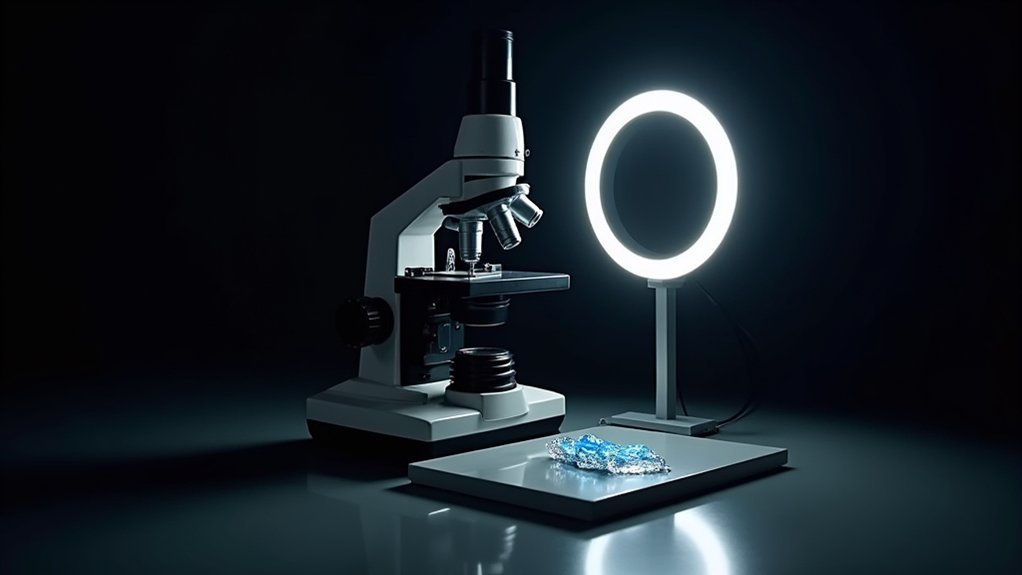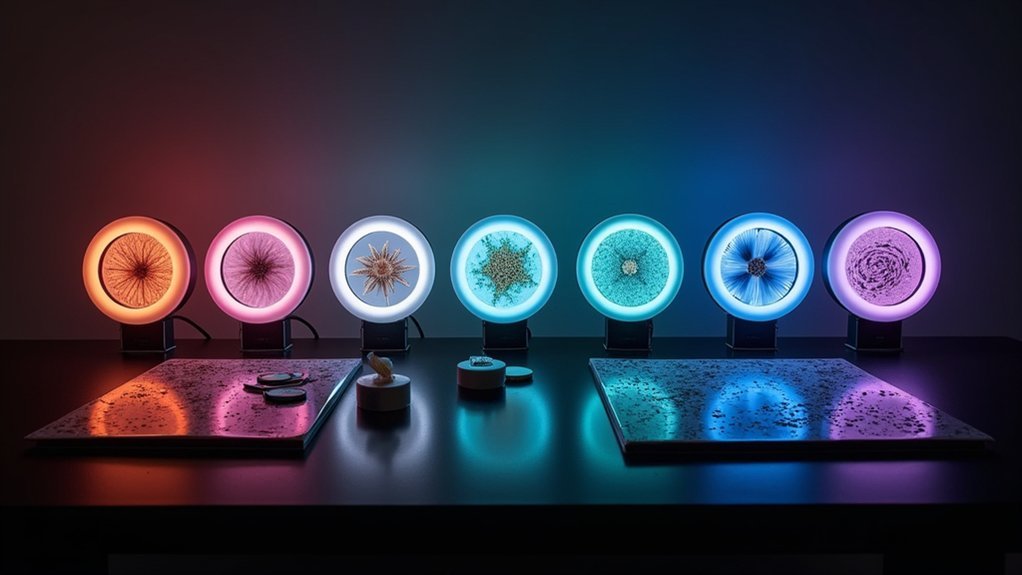To improve your microscope imaging, try these seven ring light setups: adjustable quadrant lights for directional control, polarized lights to reduce glare, diffused LEDs for shadow-free viewing, dual-angle lights for enhanced texture visibility, color temperature adjustable lights for accurate representation, gooseneck auxiliaries for targeted illumination, and combined lighting systems for thorough detail. Each setup addresses specific challenges in microscopy, from reflective specimens to delicate surface features. Discover how these illumination techniques can transform your microscopic examination work.
7 Ring Light Setups For Better Microscope Images

When working with microscopes, proper illumination can make the difference between seeing essential details and missing them entirely. An adjustable LED ring light provides uniform illumination that reveals critical features in PCBs and mechanical components that might otherwise remain hidden.
You’ll achieve clearer images by positioning your microscope ring light at the ideal working distance for your specific samples. Consider adding diffusing materials like frosted plastic to soften harsh lighting and minimize distracting reflections.
For particularly reflective specimens, combine your LED ring light with polarized filters to enhance contrast and eliminate glare.
Remember to adjust brightness settings based on your sample’s characteristics—darker specimens typically require more illumination, while highly reflective ones benefit from reduced intensity.
The right ring light setup transforms ordinary microscope work into precise, detailed observation.
Adjustable Quadrant Ring Lights for Directional Control
You’ll gain unprecedented control over microscope illumination with adjustable quadrant ring lights that let you independently manage brightness levels in each section.
When examining reflective components like PCBs, you can eliminate directional glare by dimming specific quadrants while maintaining ideal illumination from other angles.
This targeted approach guarantees your specimens’ finest details remain visible without the washout effect that traditional ring lights often produce on shiny surfaces.
Directional Glare Elimination
Inspecting reflective samples under a microscope often presents the challenge of directional glare, which can obscure critical details on shiny surfaces like PCBs and etched components.
Adjustable quadrant ring lights offer an effective solution for glare reduction by giving you precise control over illumination direction.
For ideal results when eliminating directional glare:
- Toggle individual LED quadrants to control which sections remain active, directing light away from problematic reflective angles.
- Implement polarized filters with your adjustable quadrant ring lights to further reduce surface reflections.
- Tilt your microscope head 4-5 degrees to complement your lighting setup and minimize reflection points.
- Test different configurations with individually dimmable quadrants to find the perfect lighting balance for your specific sample characteristics.
Quadrant Brightness Control
Unlike basic ring lights that only offer uniform illumination, adjustable quadrant ring lights provide precision control over each segment’s brightness, transforming how microscope users analyze complex samples.
You’ll find this feature invaluable when examining reflective surfaces, as you can dim specific quadrants to minimize glare while maintaining visibility.
With independent control of each ring light segment, you’re able to create directional lighting that highlights critical features like surface textures and fine cracks. This targeted approach enhances detail visibility by reducing unwanted shadows that might otherwise obscure important characteristics.
When inspecting samples with varying reflective properties, you can customize lighting angles to suit your specific inspection requirements.
This fine-tuning capability greatly improves image quality during microscope work, making quadrant control essential for precise industrial quality control applications.
Polarized Ring Lights for Glare Reduction on Reflective Samples

When examining highly reflective samples under a microscope, glare can often obscure critical details and compromise image quality.
Polarized ring lights offer an effective solution by filtering out unwanted reflections while enhancing surface features.
You’ll notice significant improvements when using these specialized lights:
- Reduced glare – Polarized filters minimize reflection intensity, revealing details that would otherwise be hidden.
- Enhanced surface visibility – Scratches, wetness, and other conditions become more apparent without harsh reflections.
- Improved clarity – Tilting your microscope head 4-5 degrees further reduces unwanted light bounce.
- Customizable illumination – Adjustable LED groups allow you to tailor lighting to your specific sample’s characteristics.
For precision work requiring superior image quality, polarized ring lights deliver consistently better results than traditional lighting methods.
Diffused LED Ring Lights for Soft, Shadow-Free Illumination
Diffused LED ring lights will transform your microscope imaging by eliminating harsh reflections that typically obscure fine details on reflective surfaces like PCBs or etched components.
You’ll appreciate the adjustable brightness controls that let you fine-tune illumination intensity for ideal visibility of different specimens and surface conditions.
The even distribution of light across your entire sample guarantees shadow-free examination, revealing subtle features that might otherwise be missed under conventional directional lighting.
Eliminating Harsh Reflections
Harsh reflections can obscure critical details in microscopic examinations, especially when working with shiny subjects like PCBs. Your quality control process depends on clear visibility of components and solder joints that standard light ring setups might wash out with glare.
To effectively eliminate these problematic reflections:
- Utilize diffused LED ring lights with frosted plastic coverings that scatter light evenly across your sample.
- Adjust your microscope head angle by 4-5 degrees to redirect unwanted reflections away from your viewing path.
- Take advantage of individually dimmable quadrants to create ideal lighting conditions for different surface types.
- Consider adding polarized filters to your light ring setup for examining highly reflective materials.
These modifications will dramatically improve image clarity, allowing you to spot defects and details that might otherwise remain hidden beneath blinding glare.
Adjustable Brightness Control
Three critical factors make adjustable brightness control in diffused LED ring lights essential for precise microscopic imaging.
First, you’ll achieve enhanced visibility without harsh shadows by fine-tuning illumination levels to match your specific sample requirements. The ability to adjust brightness guarantees peak contrast for various specimen types.
Second, adjustable brightness control reduces eye strain during extended inspection sessions. You’ll experience greater comfort when working with consistent, shadow-free illumination that you can customize to your visual preferences.
Finally, the long lifespan of LED ring lights (25,000-50,000 hours) means your brightness settings remain reliable throughout years of laboratory use.
Their compact design integrates seamlessly with most microscope models, allowing you to maintain operational efficiency while enjoying the benefits of evenly diffused lighting across your entire sample area.
Even Specimen Illumination
When examining intricate specimen details, diffused LED ring lights create the ideal viewing environment by distributing illumination evenly across your entire sample.
These specialized ring light systems utilize frosted plastic diffusers that considerably reduce glare on shiny surfaces, revealing details that would otherwise be lost to harsh reflections.
Your microscopy benefits from this technology in four critical ways:
- Shadow-free illumination enhances visibility of fine structures
- Consistent color temperature remains true even at low brightness settings
- Compact design won’t interfere with your microscope’s focus range
- Long-lasting LEDs (25,000-50,000 hours) provide cost-effective laboratory lighting
You’ll notice the difference immediately when viewing specimens that previously proved challenging to illuminate properly.
The soft, even light reveals textures and contours with remarkable clarity, transforming your microscopic imaging capabilities.
Dual-Angle Ring Lights for Enhanced Surface Texture Visibility
Microscopic surface details often remain hidden when illuminated from a single direction, making dual-angle ring lights an invaluable tool for thorough specimen examination.
You’ll notice immediately how these specialized light sources reveal fine textures, scratches, and imperfections that standard lighting misses.
By adjusting the dual angles, you can effectively reduce shadows and glare that typically obscure critical features.
This is particularly useful when you’re working with reflective or shiny specimens where traditional illumination creates distracting reflections.
The uniform illumination provided by dual-angle ring lights enhances contrast and clarity in your microscopic images.
Whether you’re conducting quality control inspections or research analysis, you’ll achieve superior visualization of surface characteristics, allowing you to identify details that might otherwise go undetected.
Color Temperature Adjustable Ring Lights for Accurate Sample Representation

Color accuracy represents another dimension of microscopic imaging that demands attention beyond shadow and texture control.
Color temperature adjustable ring lights offer you precise control over your sample’s appearance, ranging from warm (3000K) to cool (6000K) tones, ensuring true-to-life representation.
When working with microscopy samples, these specialized lights deliver:
- Minimal color distortion for PCBs and biological specimens where color fidelity is essential
- Consistent color temperature across brightness levels, revealing surface details easily missed with standard lighting
- Flexibility to switch between settings to uncover defects, scratches, or moisture not visible under a single light condition
- Superior documentation quality, making image comparison straightforward
This adaptability notably enhances the overall quality of your microscopic analysis and documentation.
Gooseneck Auxiliary Lights Combined With Ring Illumination
The strategic combination of gooseneck auxiliary lights with ring illumination creates a powerful lighting setup that overcomes the limitations of either system alone.
Combining gooseneck lights with ring illumination delivers superior microscopy results beyond what either system achieves independently.
You’ll gain precision control over shadows and glare, resulting in more uniform microscope images with enhanced detail visibility.
These gooseneck lights offer exceptional flexibility, allowing you to direct illumination from multiple angles to inspect complex surfaces and textures.
When paired with ring illumination, you can effectively highlight specific features on your specimens, making identification of fine details and imperfections considerably easier.
This versatile lighting approach optimizes your microscopy work across applications from routine inspections to advanced research.
You’ll appreciate how this combination enhances efficiency while providing the adaptable lighting environment necessary for capturing high-quality, shadow-free images of your samples.
Frequently Asked Questions
How Do You Take Good Pictures With a Ring Light?
Position your ring light about 10 inches from the subject, adjust brightness between 0-100%, use diffusers to soften harsh light, and experiment with different angles to reduce shadows and enhance details.
How Do You Set a Ring Light for Best Lighting?
For best lighting, position your ring light 10 inches from the subject, adjust brightness based on reflective properties, use diffusers to soften harsh light, and consider adding polarized filters to reduce glare and enhance contrast.
What Are the Disadvantages of Ring Lights?
Ring lights can create glare on reflective surfaces, produce fixed shadows, lack brightness with optical attachments, generate heat during extended use, and don’t always highlight surface textures effectively. You’ll need additional lighting for thorough inspections.
Which Light Is Best for Microscope?
For your microscope, LED ring lights are best. You’ll get uniform illumination with minimal shadows. If you’re examining reflective samples, choose polarized ring lights. Always match the light’s specifications to your microscope’s design.
In Summary
You’ll find these seven ring light setups transform your microscopy results dramatically. By selecting the right illumination technique—whether it’s directional quadrants, polarized filters for reflective specimens, or combining gooseneck auxiliaries with your primary ring light—you’ll capture clearer, more accurate images. Don’t underestimate the impact of proper lighting; it’s often the difference between mediocre and publication-quality microscope photography. Experiment with these configurations to discover what works best for your specific applications.





Leave a Reply